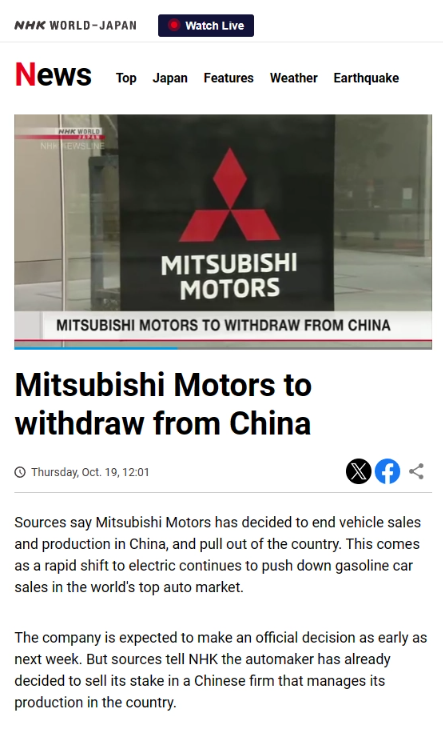
According to news on October 20, Japan's Mitsubishi Motors Corporation has recently made a major decision to terminate its automobile sales and production business in China and officially withdraw from the Chinese market.
It is understood that Mitsubishi Motors plans to officially announce this decision next week. Mitsubishi has decided to sell its stake in a joint venture in China that manages Mitsubishi's production activities in China, sources said.

The factory jointly established by Mitsubishi Motors and China Guangzhou Automobile Group in Changsha, Hunan Province was once part of the Sino-Japanese automobile joint venture market since it was put into operation in 2012. However, in March this year, the factory suspended operations and production work. Mitsubishi Motors currently faces huge challenges in the Chinese market, where electric vehicles and plug-in hybrids dominate the market and sales of traditional fuel vehicles are sluggish. Therefore, Mitsubishi Motors plans to shift its business focus to the Southeast Asian market.

As early as September 27, some media reported that Mitsubishi Motors was about to "stop production." However, Mitsubishi Motors spokesman Tetsuji Inoue said at the time that it had not yet been officially announced. The decision to withdraw from the Chinese market is being discussed with shareholders. However, now that the decision has become irreversible, Mitsubishi will become another Japanese automaker to withdraw from the Chinese market, a move that may cause other Japanese automakers to reexamine their strategies in the Chinese market.
GAC Group currently holds 50% of GAC Mitsubishi's shares, while Mitsubishi Motors and Mitsubishi Corporation hold 30% and 20% of the shares respectively. With the divestment of Mitsubishi Motors and Mitsubishi Corporation, GAC Group plans to make full use of its Hunan plant to produce electric vehicles to adapt to the changing Chinese market.
The above is the detailed content of Mitsubishi Motors announces it will withdraw from the Chinese market and will turn to the Southeast Asian market. For more information, please follow other related articles on the PHP Chinese website!




